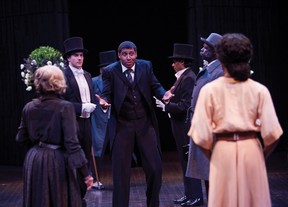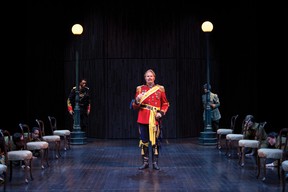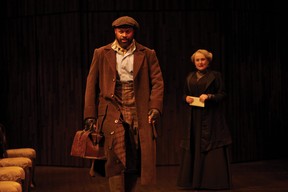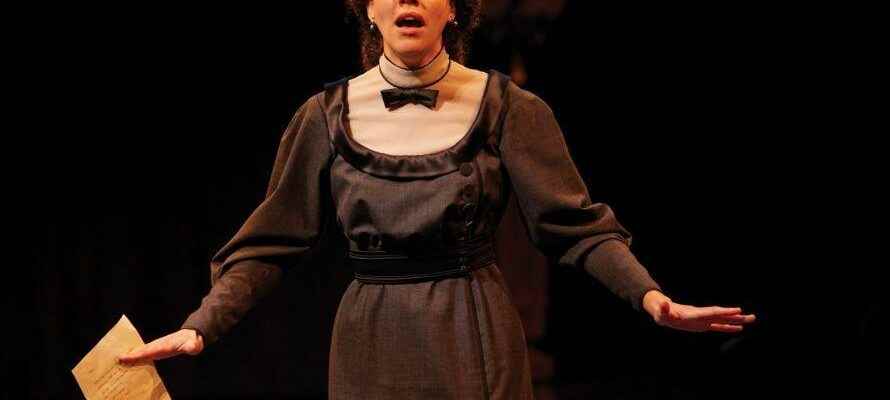Shakespeare’s morally ambiguous comedy All’s Well That Ends Well has left more than a few experts scratching their heads.
One of the English playwright’s so-called “problem plays,” it often asks more questions than it answers and audiences unfamiliar with its various dilemmas and conundrums can be forgiven for being a little confused.
How exactly does Helen’s remedy – borrowed from her late father, a renowned physician – heal the deathly-ill King of France (Ben Carlson)?
And what does she see in Bertram, exactly? The high-born son of Helen’s guardian, the Countess of Rossillion (Seana McKenna), harshly rejects her simply for being “a poor physician’s daughter” before chasing personal glory – among other things – in another country.
Helen (Jessica B. Hill) is provoked but her solution, the play’s notorious bed trick, is also ethically difficult to justify, something modern audiences will need to grapple with. Helen wins Bertram’s heart, but does the play truly end well, given the disappointment?

A companion piece to Richard III during the Stratford Festival’s first season in 1953, All’s Well That Ends Well has been given a similar role at the new Tom Patterson theater in 2022. Under the direction of Scott Wentworth, the production that opened Friday, however, offers its own twist on the modern adaptation Tyrone Guthrie presented nearly 70 years ago.
Set in the early 20th century, Wentworth drapes All’s Well That Ends Well in a backdrop that recalls the First World War. Shakespeare’s plot remains unchanged – Bertram (Jordin Hall) and his cowardly follower, Parolles (Rylan Wilkie), flee to Italy in support of the Duke of Florence – but the creative aesthetic is a refreshing touch highlighted in particular by Inez Khan’s wardrobe.

The military uniforms given by the soldiers are especially striking. A tableau in the play focused on Bertram, gleaming sword in hand surrounded by his comrades, is a beautiful visual that also benefits the controversial character’s complex arc.
In the end, of course, it’s the players that must do the heavy lifting in a script filled with flawed characters. A line by the First Lord Dumaine (Michael Blake) summarizes the challenge and an important theme: “The web of our life is of a mingled yarn, good and ill together.”
Hill and Hall, both graduates of the Festival’s Birmingham Conservatory, are successful here. Although the leads don’t actually share many scenes together, their early chemistry in a sympathetic moment creates an important foundation for their relationship, offering hope that the love and forgiveness they share later are genuine despite his crude protestations and her lamentable trickery.
McKenna and Carlson, meanwhile, are equally effective as parental figures, doling out both encouragement and admonishment, reminding the audience Bertram and Helena are both still coming of age. The Countess says:
“Even so it was with me when I was young,
If we are nature’s, these are ours. This thorn
Doth to our rose of youth rightly belong.”
Although the play is heavy on moral philosophy, All’s Well That Ends Well is still a comedy and, in this case, a comedy featuring Andre Sills.

Sills plays Lavatch – a sexton, the caretaker of a church, in Wentworth’s interpretation – and draws some of the production’s heartiest laughs. The character can sometimes be overlooked but it’s impossible to miss Sills, a master at drawing out Shakespeare’s humor who squeezes every ounce out of his time on stage. His comedic timing is perfectly suited for the play’s clever puns and innuendos.
Wilkie and Wayne Best, as Lafew, the snarky old lord in the court of France, are also hilarious. Parolles’ fall from grace is perhaps the steepest in the play and Wilkie makes it easy to root for his character’s demise. Best, meanwhile, expertly reigns in our collective schadenfreude in another of the play’s crucial moments of hope and redemption.
Final opinions about the moral quandaries in All’s Well That Ends Well will vary, but Wentworth and his cast have made sure untangling Shakespeare’s mingled yarn is an enjoyable experience.
